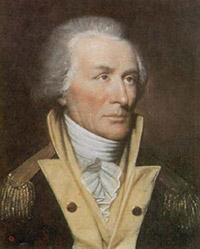
Thomas Sumter was an American military officer, planter, and politician who served in the Continental Army as a brigadier-general during the Revolutionary War. After the war, Sumter was elected to the House of Representatives and to the Senate, where he served from 1801 to 1810, when he retired. Sumter was nicknamed the "Fighting Gamecock" for his military tactics during the Revolutionary War.
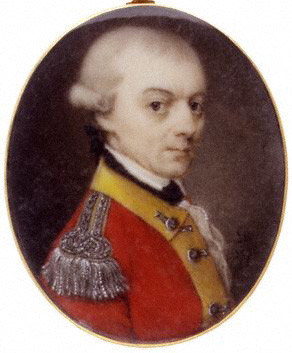
General Robert Prescott was a British military officer and colonial administrator. During a military career which spanned over fifty years, he participated in the Seven Years' War, the French and Indian War, and the American Revolutionary War, including key engagements such as the Montreal Campaign. He later became the Governor of Martinique and then, in 1796, Governor General of the Canadas, and the British Army's Commander-in-Chief for North America. He was recalled to England in 1799 after conflict with the Catholic Church and disputes with Anglo-Canadian colonial elites over the distribution of land in the colonies. He continued to hold his position until 1807, with his lieutenant governors acting in his absence. He died in 1815 after unsuccessful attempts to clear his name.
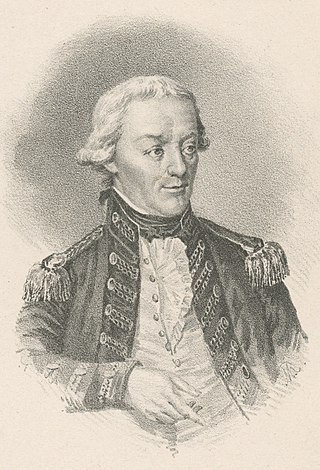
Lieutenant General Richard Prescott (1725–1788) was a British officer born in England.

Return Jonathan Meigs was a colonel in the Continental Army during the American Revolutionary War, and an early settler of the Northwest Territory. He also served as an Indian agent working with the Cherokee in East Tennessee.
Ralph Burton was a British soldier and Canadian settler.

George Luther Stearns was an American industrialist and merchant in Medford, Massachusetts, as well as an abolitionist and a noted recruiter of black soldiers for the Union Army during the American Civil War.

General Sir Robert Abercromby, GCB was a British Army officer, politician and colonial administrator who served as the governor of Bombay from 1790 to 1792. He also sat in the British House of Commons representing the constituency of Clackmannanshire and Kinross-shire from 1798 to 1802. The youngest brother of Sir Ralph Abercromby, he fought in the American War of Independence before serving in India as part of the Bombay Army, where he eventually rose to the rank of Commander-in-Chief, India.

Attakullakulla was an influential Cherokee leader and the tribe's First Beloved Man, serving from 1761 to around 1775. His son was Dragging Canoe, the first leader of the Chickamauga faction of the Cherokee tribes.
The 77th Regiment of Foot (Montgomerie's Highlanders) was a Highland Scots Regiment raised in 1757. The 77th Regiment was one of the first three Highland Regiments to fight in North America. During the Seven Years' War, the regiment lost 110 soldiers and 259 were wounded.
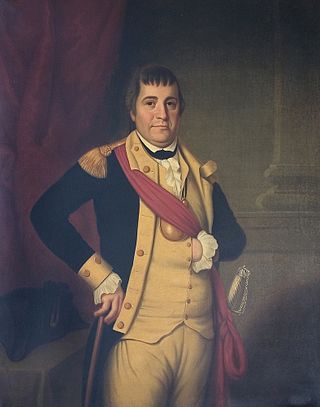
William Barton (1748–1831) was an officer in the Continental Army during the American Revolutionary War who retired with the rank of colonel. He later served as adjutant general of the Rhode Island militia.
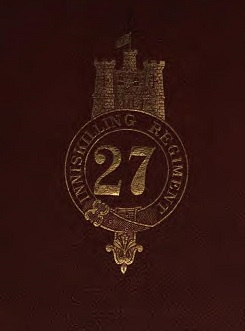
The 27th (Inniskilling) Regiment of Foot was an Irish infantry regiment of the British Army, formed in 1689. Under the Childers Reforms it amalgamated with the 108th Regiment of Foot to form the Royal Inniskilling Fusiliers in 1881.
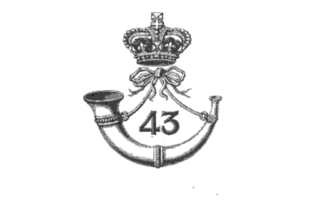
The 43rd (Monmouthshire) Regiment of Foot was an infantry regiment of the British Army, raised in 1741. Under the Childers Reforms it amalgamated with the 52nd (Oxfordshire) Regiment of Foot to form the 1st and 2nd battalions of the Oxfordshire Light Infantry in 1881. The regiment went on to become the Oxfordshire and Buckinghamshire Light Infantry in 1908.
Henry Timberlake was a colonial Anglo-American officer, journalist, and cartographer. He was born in the Colony of Virginia and died in England. He is best known for his work as an emissary from the British colonies to the Overhill Cherokee during the 1761–1762 Timberlake Expedition.

The Siege of Havana was a successful British siege against Spanish-ruled Havana that lasted from March to August 1762, as part of the Seven Years' War. After Spain abandoned its former policy of neutrality by signing the family compact with France, resulting in a British declaration of war on Spain in January 1762, the British government decided to mount an attack on the important Spanish fortress and naval base of Havana, with the intention of weakening the Spanish presence in the Caribbean and improving the security of its own North American colonies. A strong British naval force consisting of squadrons from Britain and the West Indies, and the military force of British and American troops it convoyed, were able to approach Havana from a direction that neither the Spanish governor nor the Admiral expected and were able to trap the Spanish fleet in the Havana harbour and land its troops with relatively little resistance.

The British expedition against Martinique was a military action that took place in January and February 1762. It was part of the Seven Years' War.

The Battle of Echoee, or Etchoe Pass, was a battle on June 27, 1760 during the French and Indian War, between the British and colonial force under Archibald Montgomerie and a force of Cherokee warriors under Seroweh. It took place near the present-day municipality of Otto, in Macon County, North Carolina.

The siege of Fort Loudoun was an engagement during the Anglo-Cherokee War fought from February 1760 to August 1760 between the warriors of the Cherokee led by Ostenaco and the garrison of Fort Loudoun composed of British and colonial soldiers commanded by Captain Paul Demeré.
Danks' Rangers was a ranger unit raised in colonial North America and led by Captain Benoni Danks. It was modeled on and often served alongside of the better known Gorham's Rangers. The unit was recruited in early 1756, during the early stages of the Seven Years' War / French and Indian War, from among men serving in two then-disbanding New England provincial battalions stationed in Nova Scotia. Raised to help protect the British garrison on the Isthmus of Chignecto and secure the area after the siege of Fort Beauséjour, their principle foes were Acadian and Mi'kmaq Indians conducting a low-level insurgency against the British authorities in Nova Scotia. Their primary area of operations was the northwestern portion of Nova Scotia and the north and eastern parts of what would later become New Brunswick. The unit averaged a little over one hundred men for much of its existence, although it seems to have been augmented to 125 for the attack on Havana in 1762. The company often operated in tandem with Gorham's Rangers, based out of Halifax, Nova Scotia, and after 1761, the two companies were combined into a Nova Scotia ranging corps, led by Major Joseph Gorham.

Provincial troops were military units raised by colonial governors and legislatures in British North America for extended operations during the French and Indian Wars. The provincial troops differed from the militia, in that they were a full-time military organization conducting extended operations. They differed from the regular British Army in that they were recruited only for one campaign season at the time. These forces were often recruited through a quota system applied to the militia. Officers were appointed by the provincial governments. During the eighteenth century militia service was increasingly seen as a prerogative of the social and economic well-established, while provincial troops came to be recruited from different and less deep-rooted members of the community.

British Army Independent Companies in South Carolina formed a major component of the Province of South Carolina's military security. Regular independent companies were first established in British North America in 1664. The first Independent Company in South Carolina was organized in 1721. With the raising of Oglethorpe's Regiment in 1737 it was disbanded. In 1746 three understrength independent companies were sent to South Carolina, but they were disbanded two years later. When Oglethorpe's Regiment was disbanded in 1748, three new independent companies were raised in South Carolina, partly recruited with soldiers from the disbanded regiment. These three companies participated in the French and Indian War and the Cherokee War, participating in the Battle of Fort Necessity, the Braddock Expedition, the battle of the Monongahela, and the siege of Fort Loudoun. They were disbanded in 1763, with the rest of the British army independent companies in North America.














